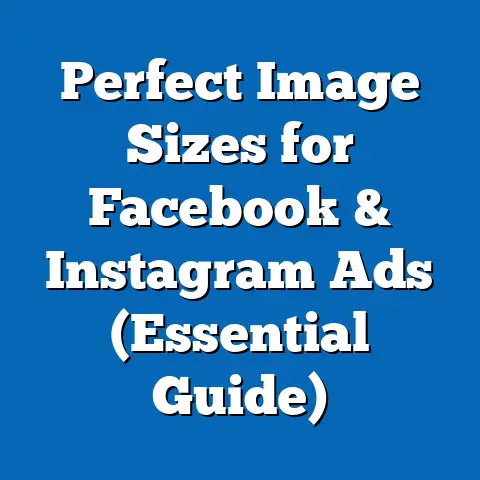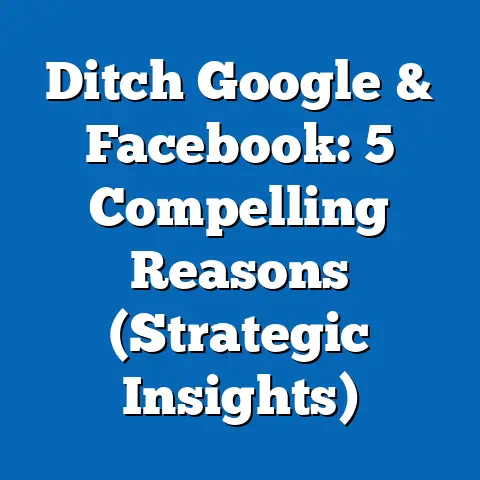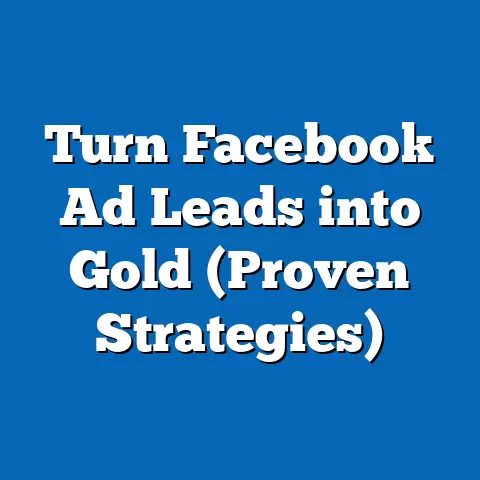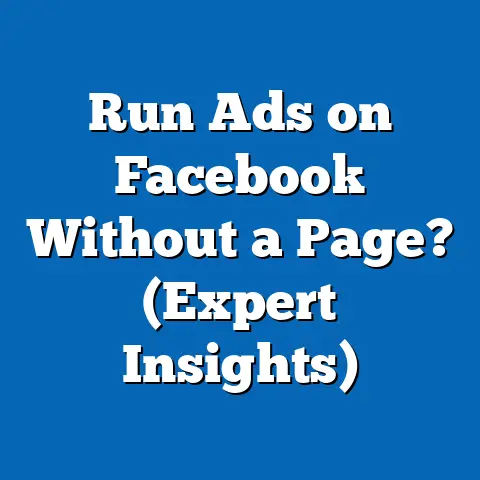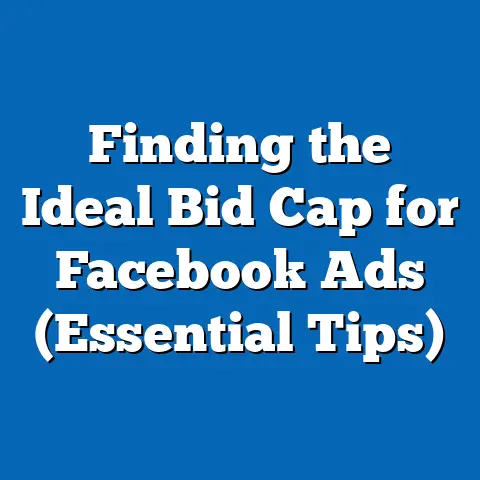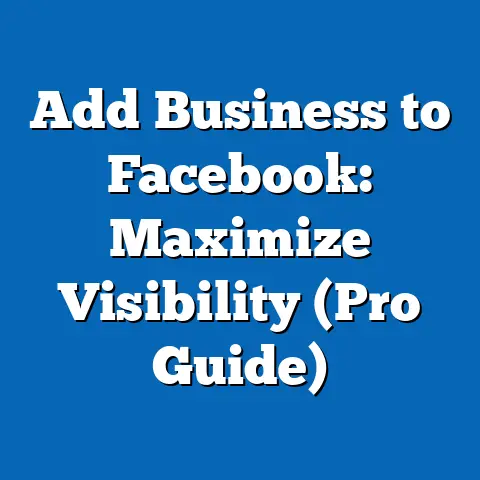Maximize Facebook Ads with a Custom Email Strategy (Unlock Success)
The digital marketing landscape is a constantly shifting terrain. Strategies that worked wonders last year might be obsolete today. Yet, through all the algorithm updates and emerging platforms, one thing has remained remarkably consistent: the power of Facebook Ads. I’ve seen it firsthand, working with businesses of all sizes, that a well-crafted Facebook Ads campaign can still drive significant traffic, generate leads, and ultimately, boost conversions.
But here’s the secret sauce I’ve learned over the years: Facebook Ads are even more effective when strategically combined with a custom email strategy. Think of it as a one-two punch. Facebook Ads grab attention and introduce your brand to a wide audience, while email marketing nurtures those leads, builds relationships, and guides them towards a purchase.
This article is your complete guide to unlocking that synergy. We’ll delve into the Facebook Ads ecosystem, explore how to build a custom email strategy, and, most importantly, show you how to seamlessly integrate the two for maximum impact. Get ready to learn how to leverage the reach of Facebook with the personalization of email, creating a marketing powerhouse that drives lasting results.
1. Understanding the Facebook Ads Ecosystem
Before we dive into the integration, let’s make sure we’re all on the same page about the fundamentals of Facebook Ads.
Facebook Ads is a robust advertising platform that allows businesses to reach a massive and highly targeted audience. As of 2023, Facebook boasts nearly 3 billion monthly active users. That’s a staggering number of potential customers! But it’s not just about the sheer volume; it’s about the precision with which you can target your ideal customer.
Types of Facebook Ads
Facebook offers a wide array of ad formats to suit different marketing objectives. Here are some of the most common:
- Image Ads: These are simple yet effective ads featuring a single image and accompanying text. I often recommend these for brand awareness campaigns or to showcase a specific product.
- Video Ads: Video is king in the digital world, and Facebook Video Ads are no exception. They’re great for capturing attention and telling a story. I’ve seen video ads dramatically increase engagement and conversions for clients in the e-commerce and service industries.
- Carousel Ads: Carousel ads allow you to showcase multiple images or videos in a single ad unit. This is perfect for highlighting different features of a product or telling a more complex story.
- Collection Ads: Collection ads are designed for e-commerce businesses. They allow users to browse products directly within the ad, making it easier to make a purchase.
- Lead Ads: These ads are specifically designed to collect leads directly within the Facebook platform. Users can fill out a form without ever leaving Facebook, making the process seamless and convenient. This is a game-changer for building your email list, as we’ll discuss later.
- Instant Experience Ads: Formerly known as Canvas Ads, these are full-screen, mobile-optimized experiences that load instantly when a user clicks on an ad. They’re great for immersive storytelling and showcasing your brand in a visually appealing way.
Targeting Options: Precision is Key
The real power of Facebook Ads lies in its granular targeting capabilities. You can target users based on a wide range of factors, including:
- Demographics: Age, gender, location, education, job title, and more.
- Interests: Hobbies, activities, pages they’ve liked, and groups they’ve joined.
- Behaviors: Past purchases, website visits, app usage, and other online behaviors.
- Custom Audiences: This is where things get really interesting. You can upload your existing customer list (including email addresses) to create a custom audience. This allows you to target your existing customers with specific ads, or to create a “lookalike audience” of people who share similar characteristics with your best customers.
The Importance of Audience Segmentation
Effective audience segmentation is crucial for maximizing the ROI of your Facebook Ads campaigns. Instead of targeting everyone, you want to focus your efforts on the people who are most likely to be interested in your products or services.
For example, let’s say you’re selling organic skincare products. You could segment your audience based on:
- Age: Target younger users (18-35) with ads promoting acne treatments and older users (35+) with ads promoting anti-aging products.
- Interests: Target users who are interested in organic beauty, natural skincare, or vegan products.
- Behaviors: Target users who have previously purchased skincare products online or visited websites that sell organic beauty products.
By segmenting your audience and tailoring your ads to their specific needs and interests, you can significantly improve your click-through rates, conversion rates, and overall ROI.
Facebook Ads and Brand Visibility
Facebook Ads can significantly boost your brand visibility. Even if users don’t click on your ads, seeing your brand name and logo repeatedly can increase brand awareness and familiarity.
I’ve often used Facebook Ads for brand awareness campaigns, focusing on reaching a large audience with visually appealing ads that showcase the brand’s personality and values. The goal is not necessarily to drive immediate sales, but to create a positive association with the brand in the minds of potential customers.
Email Marketing: Nurturing Relationships
Now, let’s shift our focus to email marketing. Email marketing is a powerful tool for nurturing relationships with potential customers and guiding them through the sales funnel.
While Facebook Ads are great for reaching a large audience, email marketing allows you to connect with individuals on a more personal level. You can send targeted emails based on their specific interests and needs, providing them with valuable information, exclusive offers, and personalized recommendations.
Combining the Power of Facebook Ads and Email
The real magic happens when you combine the reach of Facebook Ads with the personalization of email marketing. By integrating these two channels, you can create a cohesive and effective marketing strategy that drives lasting results.
Here’s how it works:
- Use Facebook Ads to generate leads: Run Lead Ads or drive traffic to a landing page where users can sign up for your email list.
- Nurture those leads with email marketing: Send targeted emails based on their interests and needs, providing them with valuable information and exclusive offers.
- Retarget email subscribers with Facebook Ads: Create custom audiences based on your email list and target them with specific ads on Facebook.
This integrated approach allows you to reach a wider audience, nurture leads, and drive conversions more effectively than using either channel in isolation.
Takeaway: Facebook Ads provide the reach, while email marketing provides the personalization. Combining them is a recipe for marketing success. Next, we’ll explore how to build a custom email strategy that complements your Facebook Ads efforts.
2. Building Your Custom Email Strategy
A generic, one-size-fits-all email blast is unlikely to resonate with your audience. That’s why building a custom email strategy is crucial for success. A custom email strategy is all about tailoring your email marketing efforts to the specific needs and interests of your target audience.
What is a Custom Email Strategy?
A custom email strategy involves segmenting your email list, creating personalized email content, and optimizing your email campaigns based on data insights. It’s about going beyond the basics and creating a truly engaging and valuable experience for your subscribers.
I’ve seen firsthand the difference a custom email strategy can make. One of my clients, a local bakery, was sending out generic email newsletters to their entire list. After implementing a custom email strategy that segmented their list based on customer preferences (e.g., bread lovers, pastry enthusiasts, cake aficionados), they saw a 30% increase in email open rates and a 20% increase in sales.
Segmenting Your Email List
The foundation of a custom email strategy is segmenting your email list. This involves dividing your subscribers into smaller groups based on shared characteristics, such as:
- Demographics: Age, gender, location, income level, and more.
- Interests: Hobbies, activities, products they’ve purchased, and content they’ve consumed.
- Behavior: Website visits, email opens, clicks, and purchases.
- Purchase History: What products have they bought, how frequently do they buy, and how much do they spend?
- Engagement Level: How often do they open your emails and click on links?
There are many different ways to segment your email list, and the best approach will depend on your specific business and target audience. However, the key is to identify the characteristics that are most relevant to your marketing goals and use those to create meaningful segments.
Creating Engaging and Personalized Email Content
Once you’ve segmented your email list, you can start creating engaging and personalized email content that resonates with each segment.
Personalization goes beyond simply including the subscriber’s name in the email. It’s about tailoring the content to their specific interests and needs.
For example, if you’re sending an email to subscribers who have previously purchased organic skincare products, you could include:
- Recommendations for other organic skincare products that they might be interested in.
- Tips for using organic skincare products to achieve specific results.
- Exclusive offers on organic skincare products.
By providing valuable and relevant content, you can build trust with your subscribers and increase the likelihood that they’ll engage with your emails and make a purchase.
Timing and Frequency: Finding the Sweet Spot
The timing and frequency of your email marketing campaigns can also have a significant impact on their effectiveness. You want to send emails at times when your subscribers are most likely to be receptive to your message.
According to various studies, the best times to send emails are typically mid-morning or early afternoon on weekdays. However, the optimal timing may vary depending on your specific target audience and industry.
It’s also important to consider the frequency of your emails. You don’t want to bombard your subscribers with too many emails, as this can lead to unsubscribes. On the other hand, you don’t want to send too few emails, as this can cause your subscribers to forget about you.
A good rule of thumb is to send emails at least once a month, but no more than once a week. However, you should experiment with different frequencies to see what works best for your audience.
Examples of Successful Email Campaigns
To give you some inspiration, here are a few examples of successful email campaigns that have complemented Facebook Ads:
- Welcome Email Series: A series of emails sent to new subscribers, welcoming them to your list, introducing your brand, and providing them with valuable information.
- Abandoned Cart Emails: Emails sent to customers who have added items to their cart but haven’t completed the purchase. These emails can remind them about the items in their cart and offer them a discount or free shipping to encourage them to complete the purchase.
- Product Recommendation Emails: Emails that recommend products based on the subscriber’s past purchases or browsing history.
- Promotional Emails: Emails that promote specific products or services, often with a limited-time offer.
- Birthday Emails: Emails sent to subscribers on their birthday, offering them a special discount or free gift.
Takeaway: A custom email strategy is about understanding your audience and delivering personalized content that resonates with them. Experiment with segmentation, content, timing, and frequency to find what works best for your business. Next, we’ll explore how to integrate your Facebook Ads with your custom email strategy.
3. Integrating Facebook Ads with Your Email Strategy
Now for the exciting part: How do you actually connect your Facebook Ads and email marketing efforts? This integration is where the magic happens, allowing you to create a synergistic marketing machine.
Creating a Seamless Connection
The key to a successful integration is to create a seamless connection between your Facebook Ads and your email marketing efforts. This means making it easy for users to sign up for your email list through your Facebook Ads, and then using your email list to retarget those users with specific ads on Facebook.
Capturing Leads Through Facebook Ads
There are several ways to capture leads through Facebook Ads:
- Lead Ads: As mentioned earlier, Lead Ads are specifically designed to collect leads directly within the Facebook platform. They offer a frictionless sign-up process, making it easy for users to provide their contact information. I’ve found Lead Ads to be particularly effective for mobile users, as they eliminate the need to navigate to a separate landing page.
- Driving Traffic to a Landing Page: You can also drive traffic to a dedicated landing page on your website where users can sign up for your email list. This allows you to provide more information about your offer and capture more detailed information from your subscribers.
- Using a Facebook Tab: You can create a custom tab on your Facebook page that promotes your email list and allows users to sign up directly from your page.
Regardless of which method you choose, it’s important to make it clear to users what they’ll be getting in exchange for signing up for your email list. Offer them a valuable incentive, such as a free ebook, a discount code, or exclusive access to content.
Using Custom Audiences and Retargeting
Once you’ve captured leads through Facebook Ads, you can use those leads to create custom audiences and retarget those users with specific ads on Facebook.
Here’s how it works:
- Upload your email list to Facebook: Facebook allows you to upload your email list and match it with Facebook users.
- Create a custom audience: Once your email list is uploaded, you can create a custom audience based on those users.
- Retarget your custom audience with specific ads: You can then target your custom audience with specific ads on Facebook, such as ads promoting your products or services, ads offering exclusive discounts, or ads driving traffic to your website.
Retargeting is a powerful technique that allows you to re-engage users who have already shown an interest in your brand. By targeting your email subscribers with specific ads on Facebook, you can increase the likelihood that they’ll convert into customers.
Designing Facebook Ads for Email Sign-Ups
When designing Facebook Ads to encourage email sign-ups, keep the following tips in mind:
- Use compelling visuals: Use high-quality images or videos that capture attention and showcase the value of your offer.
- Write persuasive copy: Clearly communicate the benefits of signing up for your email list. What will users get in exchange for their email address?
- Include a strong call to action: Tell users exactly what you want them to do. Use phrases like “Sign Up Now,” “Get Your Free Ebook,” or “Join Our Mailing List.”
- Target the right audience: Make sure you’re targeting the right audience with your ads. Use Facebook’s targeting options to reach users who are most likely to be interested in your offer.
- A/B test your ads: Experiment with different ad copy, visuals, and calls to action to see what works best.
A/B Testing for Optimization
A/B testing is essential for optimizing both your Facebook Ads and your email campaigns. This involves creating two different versions of an ad or email and then testing them against each other to see which one performs better.
For example, you could A/B test different ad copy, visuals, or calls to action in your Facebook Ads. You could also A/B test different subject lines, email content, or calls to action in your email campaigns.
By A/B testing your ads and emails, you can identify the elements that are most effective and then use those elements to improve your overall marketing performance.
Takeaway: Integrating Facebook Ads with your email strategy is about creating a seamless connection that allows you to capture leads, nurture relationships, and drive conversions more effectively. Use Lead Ads, custom audiences, and A/B testing to optimize your results. Next, we’ll explore how to measure the success of your integrated strategy.
4. Measuring Success
You’ve implemented your integrated Facebook Ads and email strategy, but how do you know if it’s actually working? Measuring the success of your campaigns is crucial for understanding what’s working, what’s not, and how you can improve your results over time.
Key Performance Indicators (KPIs)
Key Performance Indicators (KPIs) are specific, measurable metrics that you can use to evaluate the effectiveness of your marketing campaigns. Here are some of the most important KPIs to track for your integrated Facebook Ads and email strategy:
- Facebook Ads KPIs:
- Reach: The number of unique users who saw your ad.
- Impressions: The number of times your ad was displayed.
- Click-Through Rate (CTR): The percentage of users who clicked on your ad after seeing it.
- Cost Per Click (CPC): The average cost you paid for each click on your ad.
- Conversion Rate: The percentage of users who completed a desired action (e.g., signing up for your email list) after clicking on your ad.
- Cost Per Acquisition (CPA): The average cost you paid for each conversion.
- Email Marketing KPIs:
- Open Rate: The percentage of subscribers who opened your email.
- Click-Through Rate (CTR): The percentage of subscribers who clicked on a link in your email.
- Conversion Rate: The percentage of subscribers who completed a desired action (e.g., making a purchase) after clicking on a link in your email.
- Unsubscribe Rate: The percentage of subscribers who unsubscribed from your email list.
- Return on Investment (ROI): The overall profitability of your email marketing campaigns.
- Reach: The number of unique users who saw your ad.
- Impressions: The number of times your ad was displayed.
- Click-Through Rate (CTR): The percentage of users who clicked on your ad after seeing it.
- Cost Per Click (CPC): The average cost you paid for each click on your ad.
- Conversion Rate: The percentage of users who completed a desired action (e.g., signing up for your email list) after clicking on your ad.
- Cost Per Acquisition (CPA): The average cost you paid for each conversion.
- Open Rate: The percentage of subscribers who opened your email.
- Click-Through Rate (CTR): The percentage of subscribers who clicked on a link in your email.
- Conversion Rate: The percentage of subscribers who completed a desired action (e.g., making a purchase) after clicking on a link in your email.
- Unsubscribe Rate: The percentage of subscribers who unsubscribed from your email list.
- Return on Investment (ROI): The overall profitability of your email marketing campaigns.
Analyzing Metrics for Insights
By tracking these KPIs, you can gain valuable insights into customer behavior and the effectiveness of your marketing campaigns.
For example, if you see a low click-through rate on your Facebook Ads, it could indicate that your ad copy or visuals are not compelling enough. If you see a high unsubscribe rate on your email campaigns, it could indicate that you’re sending too many emails or that your content is not relevant to your subscribers.
By analyzing these metrics, you can identify areas for improvement and then make adjustments to your campaigns to improve your results.
Conversion Tracking and ROI Analysis
Conversion tracking is essential for understanding how your marketing campaigns are driving sales and generating revenue. By tracking conversions, you can see which ads and emails are most effective at converting leads into customers.
ROI analysis allows you to calculate the overall profitability of your marketing campaigns. By comparing the cost of your campaigns to the revenue they generate, you can determine whether your campaigns are generating a positive return on investment.
Tools for Tracking and Measuring Performance
There are a variety of tools and software that can help you track and measure the performance of your integrated Facebook Ads and email strategy. Some popular options include:
- Facebook Ads Manager: Facebook’s built-in advertising platform provides detailed metrics on your ad performance.
- Google Analytics: Google Analytics can track website traffic and conversions from both your Facebook Ads and your email campaigns.
- Email Marketing Platforms: Most email marketing platforms, such as Mailchimp, Klaviyo, and ConvertKit, provide detailed metrics on your email performance.
- Attribution Tools: Attribution tools, such as Wicked Reports and Triple Whale, can help you track the customer journey and attribute sales to specific marketing channels.
Continual Refinement Based on Data
The key to maximizing the success of your integrated Facebook Ads and email strategy is to continually refine your approach based on data insights.
Regularly review your KPIs, analyze your metrics, and identify areas for improvement. Experiment with different ad copy, visuals, email content, and targeting options. Track your results and make adjustments as needed.
By continually refining your strategy based on data, you can ensure that your campaigns are always performing at their best.
Takeaway: Measuring success is about tracking the right KPIs, analyzing the data, and continually refining your strategy based on what you learn. Use the tools available to you to gain insights and optimize your performance. Next, we’ll explore some real-world examples of businesses that have successfully integrated Facebook Ads with their email marketing strategies.
5. Case Studies and Real-World Examples
Let’s take a look at some real-world examples of businesses that have successfully integrated Facebook Ads with their email marketing strategies. These case studies will provide you with valuable insights and inspiration that you can apply to your own campaigns.
Case Study 1: E-commerce Fashion Brand
Challenge: This e-commerce fashion brand was struggling to generate consistent sales through Facebook Ads. They were spending a significant amount of money on ads, but they weren’t seeing the desired return on investment.
Solution: The brand implemented an integrated Facebook Ads and email strategy. They started running Lead Ads on Facebook, offering a 10% discount code to users who signed up for their email list. They then used their email list to send targeted emails to their subscribers, promoting new arrivals, exclusive offers, and styling tips.
They also created custom audiences based on their email list and retargeted those users with specific ads on Facebook, showcasing the products that they had previously viewed on the website.
Results:
- 30% increase in email sign-ups.
- 20% increase in website traffic from email campaigns.
- 15% increase in overall sales.
Key Takeaways:
- Offering a valuable incentive (e.g., a discount code) can significantly increase email sign-ups.
- Targeted email campaigns can drive significant traffic to your website.
- Retargeting email subscribers with specific ads on Facebook can increase sales.
Case Study 2: Local Restaurant
Challenge: This local restaurant was struggling to attract new customers. They had a Facebook page, but they weren’t sure how to use it to effectively promote their business.
Solution: The restaurant implemented an integrated Facebook Ads and email strategy. They started running Facebook Ads that promoted their lunch specials and invited users to sign up for their email list to receive exclusive discounts and promotions.
They then used their email list to send weekly emails to their subscribers, featuring their latest lunch specials, upcoming events, and a coupon for a free appetizer.
Results:
- 40% increase in email sign-ups.
- 25% increase in lunch traffic.
- 10% increase in overall revenue.
Key Takeaways:
- Facebook Ads can be a great way to promote your business to a local audience.
- Offering exclusive discounts and promotions can incentivize users to sign up for your email list.
- Regular email communication can keep your business top of mind and drive repeat business.
Case Study 3: Software Company
Challenge: This software company was struggling to generate qualified leads for their sales team. They were running Facebook Ads, but they weren’t attracting the right type of leads.
Solution: The company implemented an integrated Facebook Ads and email strategy. They started running Lead Ads on Facebook, offering a free trial of their software to users who signed up for their email list.
They then used their email list to send targeted emails to their subscribers, providing them with valuable information about their software, case studies, and testimonials.
Results:
- 50% increase in qualified leads.
- 30% increase in sales demos.
- 20% increase in overall revenue.
Key Takeaways:
- Offering a free trial can be a great way to generate qualified leads for your sales team.
- Targeted email campaigns can provide valuable information and build trust with potential customers.
- An integrated Facebook Ads and email strategy can significantly improve your lead generation efforts.
Takeaway: These case studies demonstrate the power of integrating Facebook Ads with email marketing. By implementing a cohesive strategy, businesses of all sizes can achieve significant results. Now, let’s wrap up with some final thoughts and a call to action.
Conclusion
We’ve covered a lot of ground in this article, exploring the Facebook Ads ecosystem, building a custom email strategy, integrating the two for maximum impact, measuring success, and examining real-world examples.
I hope you now have a clear understanding of how to leverage the reach of Facebook with the personalization of email to create a marketing powerhouse that drives lasting results.
Remember, the key to success is to:
- Understand your audience: Segment your email list and tailor your content to their specific needs and interests.
- Create a seamless connection: Make it easy for users to sign up for your email list through your Facebook Ads, and then use your email list to retarget those users with specific ads on Facebook.
- Measure your results: Track your KPIs, analyze your metrics, and continually refine your strategy based on what you learn.
Now it’s time to take action! I encourage you to take the first steps toward integrating Facebook Ads with your email marketing efforts. Start by identifying your target audience, segmenting your email list, and creating a compelling offer to incentivize users to sign up for your email list.
By unlocking the synergy between these two powerful marketing tools, you can increase engagement, drive conversions, and achieve overall business success. So go ahead, start experimenting, start testing, and start seeing the results! You might be surprised at the impact a well-integrated Facebook Ads and email strategy can have on your business. Good luck!

